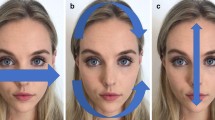Abstract
Introduction
Photography is indispensable for plastic surgery. On-camera flashes can result in bleached out detail and colour. This is why most of the plastic surgery clinics prefer studio lighting similar to professional photographers’. In this article, we want to share a simple alternative to studio lighting that does not need extra space: Ring light.
Methods
We took five different photographs of the same person with five different camera and lighting settings: Smartphone and ring light; point and shoot camera and on-camera flash; point and shoot camera and studio lighting; digital single-lens reflex (DLSR) camera and studio lighting; DSLR and ring light. Then, those photographs were assessed objectively with an online survey of five questions answered by three distinct populations: plastic surgeons (n: 28), professional portrait photographers (n: 24) and patients (n: 22) who had facial aesthetic procedures.
Results
Compared to the on-camera flash, studio lighting better showed the wrinkles of the subject. The ring light facilitated the perception of the wrinkles by providing homogenous soft light in a circular shape rather than bursting flashes. The combination of a DSLR camera and ring light gave the oldest looking subject according to 64 % of responders. The DSLR camera and the studio lighting demonstrated the youngest looking subject according to 70 % of the responders. The majority of the responders (78 %) chose the combination of DSLR camera and ring light that exhibited the wrinkles the most.
Conclusions
We suggest using a ring light to obtain well-lit photographs without loss of detail, with any type of cameras. However, smartphones must be avoided if standard pictures are desired.
Level of Evidence IV
This journal requires that authors assign a level of evidence to each article. For a full description of these Evidence-Based Medicine ratings, please refer to the Table of Contents or the online Instructions to Authors www.springer.com/00266.







Similar content being viewed by others
References
Rogers BO (1991) The first pre- and post-operative photographs of plastic and reconstructive surgery: contributions of Gurdon Buck (1807-1877). Aesthetic Plast Surg 15(1):19–33
DiBernardo BE et al (1998) Photographic standards in plastic surgery. Plast Reconstr Surg 102(2):559–568
Becker DG, Tardy ME Jr (1999) Standardized photography in facial plastic surgery: pearls and pitfalls. Facial Plast Surg 15(2):93–99
Persichetti P et al (2007) Digital photography in plastic surgery: how to achieve reasonable standardization outside a photographic studio. Aesthetic Plast Surg 31(2):194–200
Yavuzer R, Smirnes S, Jackson IT (2001) Guidelines for standard photography in plastic surgery. Ann Plast Surg 46(3):293–300
Archibald DJ, Carlson ML, Friedman O (2010) Pitfalls of nonstandardized photography. Facial Plast Surg Clin North Am 18(2):253–266 Table of Contents
Galdino GM, DaSilva D, Gunter JP (2002) Digital photography for rhinoplasty. Plast Reconstr Surg 109(4):1421–1434
Shah AR, Dayan SH, Hamilton GS 3rd (2005) Pitfalls of photography for facial resurfacing and rejuvenation procedures. Facial Plast Surg 21(2):154–161
Hagan K, Spear M (2009) Setting up your office for clinical photography. Plast Surg Nurs 29(4):203–209 quiz 210-1
Swamy RS, Most SP (2010) Pre- and postoperative portrait photography: standardized photos for various procedures. Facial Plast Surg Clin North Am 18(2):245–252 Table of Contents
What is Ring Flash Photography? http://ringlightphotography.com/what-is-ring-flash-photography/. Accessed 15 Feb 2014
Humphrey CD, Kriet JD (2010) Intraoperative photography. Facial Plast Surg Clin North Am 18(2):329–334 Table of Contents
Acknowledgments
We hereby thank Satı Şahin for being our photography model. In addition, we thank all the survey respondents.
Author contribution
Utku Can DÖLEN, collected the data, reviewed the literature and wrote the article. Selçuk ÇINAR, took the photographs and wrote the article.
Author information
Authors and Affiliations
Corresponding author
Ethics declarations
Conflict of interest
None of the authors has a financial interest in any of the products, devices or drugs mentioned in this manuscript.
Electronic supplementary material
Below is the link to the electronic supplementary material.
Rights and permissions
About this article
Cite this article
Dölen, U.C., Çınar, S. Perfect Lighting for Facial Photography in Aesthetic Surgery: Ring Light. Aesth Plast Surg 40, 319–326 (2016). https://doi.org/10.1007/s00266-016-0614-0
Received:
Accepted:
Published:
Issue Date:
DOI: https://doi.org/10.1007/s00266-016-0614-0




